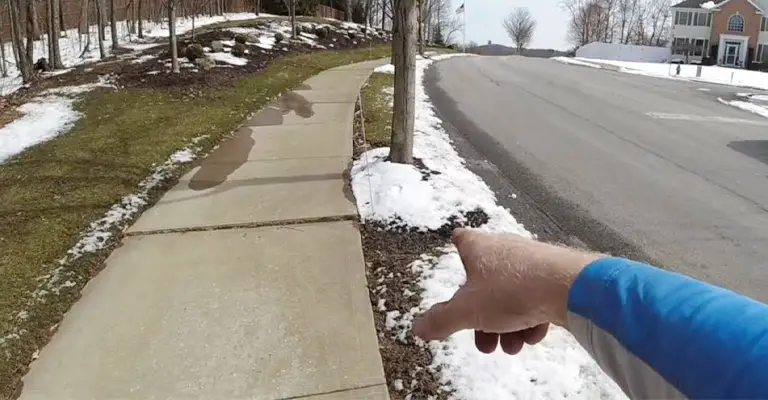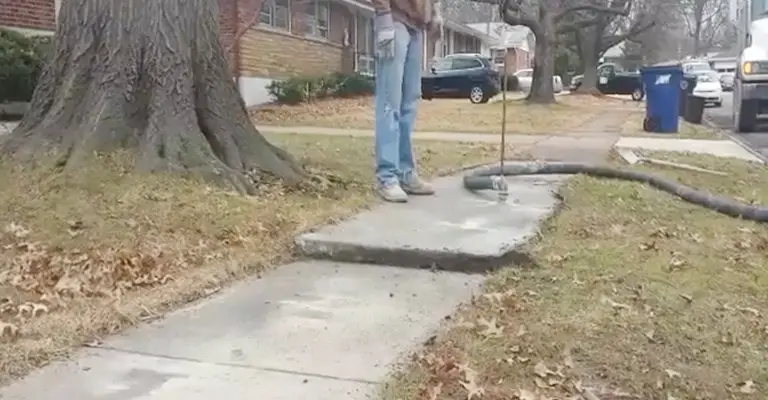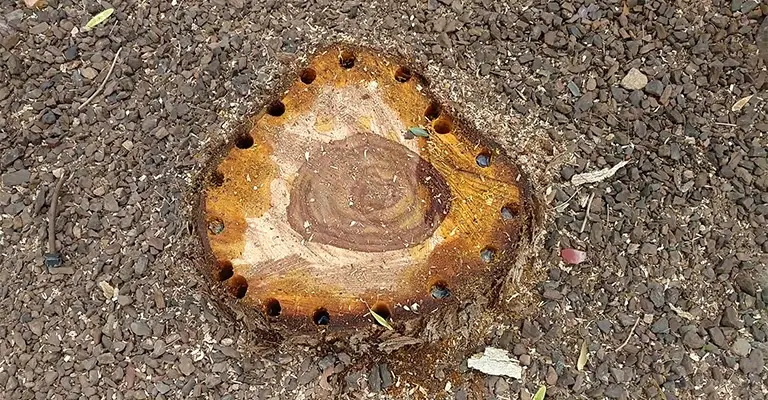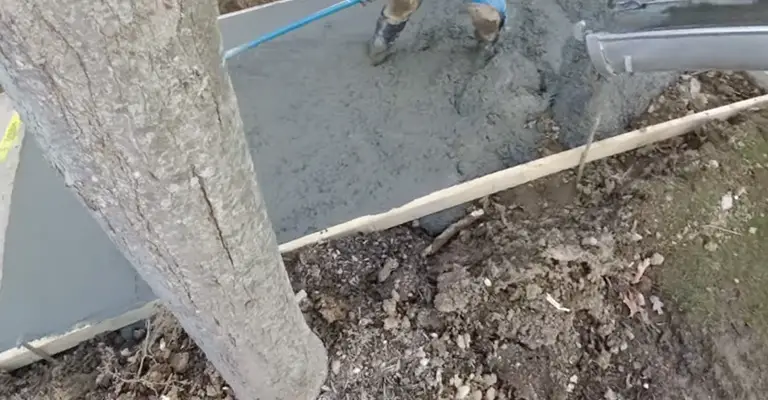As urban landscapes continue to evolve, the interplay between human development and the natural environment becomes increasingly important.
Trees, with their numerous ecological and aesthetic benefits, play a vital role in this delicate balance.
However, the desire to create new structures or expand existing ones often brings about the challenge of integrating construction activities with the preservation of these valuable arboreal companions.
One common question that arises in such scenarios is whether it’s possible to pour concrete over tree roots without causing harm.
Can You Pour Concrete Over Tree Roots?
You may feel a little nervous about building around a tree, especially if you don’t want to compromise it. With the right information and resources, however, you can do the job without much difficulty.
You should keep a few things in mind before building an outdoor living space if you plan to do so.
The canopy of the trees is the most important. Basically, this is the shade-producing area surrounding the trunk of the tree.
The tree’s roots and branches should be protected from concrete pours near them because that increases the chance of compromising them. Due to the limited space in an urban area, this is pretty unrealistic.
It’s still not recommended to pour concrete over tree roots, or any other permanent material, for that matter. It is always possible for the roots to grow, shift around, and crack the surface as time goes on.
Additionally, this can seriously compromise the root of the tree and the whole tree, aside from damaging the concrete. Roots are also at risk if the tree leans to one side.
The root’s sensitivity should also be considered. They are more vulnerable to being compromised if they are sensitive.
What to Consider When Building a Concrete Patio Over Tree Roots

The process of pouring concrete over tree roots can be challenging, but it’s not impossible. The roots of trees require constant watering, so pouring concrete on top of them can cause them to die, but not immediately.
Small roots are often killed off when large roots are removed. It will be necessary to provide space for the tree to grow and receive water if you plan to pour a new patio around an existing tree.
As the tree matures, the concrete is likely to crack. You can prevent problems caused by roots by using techniques such as root pruning or root barriers.
First, you must understand how to prepare the space for a concrete patio in order to determine if it’s possible to build a patio over tree roots.
It is easy and efficient to install a paver patio or concrete patio slab, and they rank high among the options available.
Over their counterparts, concrete slabs are easier to maintain and do not facilitate weed growth through their floors, so weeds can’t easily sprout.
As much as you want your project to proceed, you also want the trees’ best interests to be taken into consideration when installing your new patio.
A tree’s roots are its lifeline, and when they are brutally handled, the tree’s life is at risk.
Can you wind up chopping off the roots, abandoning your project, or doing your best to ensure the tree survives after all that trauma?
A mix of sand and cement creates concrete, which when mixed in the correct ratios, can endure harsh weather conditions and last for a long time.
Problems With Concrete Over Tree Roots

A concrete worker is not an arborist or a landscaper. Concrete laying is their expertise, not tree planting.
Concrete workers are not the right people to ask how the concrete will affect trees near your home when they are giving you a bid on a driveway, patio, or sidewalk.
You should call an arborist if you have large trees you want to keep safe and healthy prior to placing a concrete structure so that the roots are not damaged.
You should then contact a concrete company. In the case of tree removal or concrete redoing, a little planning ahead can save you a lot of money.
In order to make way for concrete areas, tree roots are often pruned or cut. Trees can suffer greatly from this practice. Tall, top-heavy trees are anchored to the ground by their roots.
High winds and strong weather can easily damage a tree when major roots are cut. Water, oxygen, and other nutrients are also absorbed by the roots of trees.
Trees will die back if half their roots are cut off, because they lack water and nutrients. The fresh cuts can also be penetrated by insects or diseases, causing the tree to become infected.
The roots of older trees are particularly vulnerable to root pruning, but you may be able to grow them back if you prune them to make way for concrete patios, sidewalks, or driveways.
What To Do If I Accidentally Poured Concrete Over Tree Roots?
Oh no! I accidentally poured concrete over tree roots…now what? There is not much that can be done if concrete has been poured directly on the ground and tree roots.
A thick paver base should be put down over the concrete once it has been removed and re-done. It is best if this is done away from the root zone of the tree. Although the damage may already have been done, concrete should be removed from tree roots.
It is important to keep an eye on the overall health of the tree. Stress or damage to trees usually does not show up immediately. The effects of a tree can usually be seen after a year or two.
Can Tree Roots Cause Concrete Damage?
It is possible for tree roots to penetrate concrete sidewalk slabs, patios, and slab homes, causing destruction and costing a great deal of money to repair.
To strengthen and prevent foundation problems, thicker concrete pours are often reinforced with wire mesh or rebar grids.
Again, it depends on the type of tree growing near the concrete slab. A smaller tree’s roots do not pose a threat. A giant tree however would defer structures to get its way because of its extensive roots.
Consider these factors when laying slabs over tree roots:
- Can you tell me when the concrete slab was installed?
- Did it happen when the tree was young?
It is important to consider the species of the tree, as well as its mature size.
It is rare for tree roots to penetrate the surface of a compact concrete foundation unless the slab has already been broken or cracked.
It is possible for water to reach the soil through cracked concrete. Roots of existing trees will find a way to penetrate the concrete slab when roots are present under it.
A tree’s root system expands as it grows, leaving behind stronger, longer roots. The larger they become, the more space they need to occupy, and so they push the soil aside to expand.
As a result of large tree roots and rising soil, heaving occurs when the concrete is pushed upward. There is a risk of tripping on the uneven concrete slabs.
In order for a tree to survive and grow steadily, its roots must spread and explore as far as possible. A tree is stronger when its sources are larger.
Concrete floors and slabs can be damaged by the vigorous growth of tree roots. It is natural for trees to maneuver around barriers, especially the bends in concrete floors or slabs where they could potentially damage the end.
When the roots grow, they exert pressure, and the once comfortable curve is now squeezed. There will be a lift in the corner of the concrete pad.
Working Around A Tree Root

How can a landscape be created?
There are a few materials that could be used, which vary in shape, price, and size, depending on the situation.
If you know what you want and what appeals to you, you can find it. Listed below are a few ideas:
Mulch
Among all the options, this is the most cost-effective and least invasive. Chipmulch.com or your local landfills both offer free distribution of this product.
It also decomposes into the soil, adding nutrients to the soil since it’s a natural material! Mulch allows the roots to move, just like gravel, but it won’t press down on them or trap heat, since it isn’t heavy.
In this case, you’d need to find a fitting aesthetic, since it’s the most informal.
Deck
There is a combination of gravel and pavers in this one. As a result, a level surface can be achieved, which makes it much easier for water to pass through.
Additionally, a deck requires less digging since you only need to pierce the posts in specific locations. Your root won’t be disrupted if you’re careful.
The deck can also be placed above the roots, not directly on them, by leaving a space between them and the ground. As a result, they would be able to move and grow as much as they want without being weighed down by something heavier.
You still need to keep an eye on one thing despite all this. Moisture trapped under gravel can cause rotting. Due to the good airflow provided by a deck, this is also not as common as it used to be.
Gravel
Gravel generally creates an irregular surface. While not quite as level as pavers, it’s much better than messing with the roots too much.
As with pavers, roots would be able to move pretty much however they want. In this case, however, you will not have to move the objects yourself.
Additionally, it will allow water to reach the root and is much less invasive. It’s also less expensive!
You can also use a blower to do all the cleaning of fallen leaves, either picking them up or blowing them away.
A gravel area is also a good place for adding moisture. This is great for trees if you live in a dry area.
The problem with that is that it can cause rot and/or fungus. Even though it’s not too common, it’s worth keeping an eye on.
It should be noted that gravel, although not as heavy as a paver, can get heavy if too much is applied.
You can add so much that it becomes too heavy for the water to flow through. In addition, it can hold heat and make soil even hotter, especially in full sun.
Pavers
A paver surface will have the appearance of concrete as closely as possible.
As long as the roots do not disrupt them, they will form a nice leveled area and can be moved around and repositioned as necessary.
It is important to keep in mind that these trees remain heavy and could push down on the roots. Additionally, if you’re using traditional pavers, you’ll probably have to dig quite a bit of soil to place them.
To avoid interrupting the root and compromising it, you must be very careful.
Moreover, pavers require a class 2 base, which is essentially gravel, sand, and dirt put down in 14-inch increments and compacted thoroughly. As a result, water can have a hard time moving through.
Limiting the hardscape – or landscaping elements that are non-living – around a tree will allow more space for softscape.
What to do with Tree Roots Covered in Concrete?
It is impossible for tree roots to absorb water, oxygen, or nutrients if they are covered in concrete. Concrete is normally not poured directly on tree roots or bare ground by professional concrete workers.
It is usually done by placing plenty of gravel paver base and/or sand on the ground, compacting it, and then pouring concrete on top. The gravel base may also be covered with metal grids.
A layer of gravel or metal grid will prevent tree roots from growing deeper, as will a layer of compacted gravel. Concrete slabs are also prevented from being heaved up by roots by using metal grids or rebar.
How to Keep Tree Roots from Breaking Concrete Patios
There are several ways to prevent tree roots from damaging concrete:
Relocating Trees Near Concrete Is A Good Idea
Your tree may need to be repositioned somewhere else where its roots will not cause damage to your concrete if it has caused significant damage. Find an appropriate location for replanting to prevent this from happening again.
The Use Of Root Barriers Between Trees And Concrete
The installation of root barriers makes protecting your trees easy. These tree root barriers are available in a variety of materials, including metal or plastic, and are an inexpensive way to prevent roots from expanding and causing damage to nearby surfaces.
Do Annual Tree Root Pruning
By cutting away problem-causing roots every few years with a root saw or pruning shears, we can keep them under control and prevent further damage.
Grinding the Tree Stumps and Roots
Unfortunately, there are times when trees need to be removed. A stump grinder may be necessary when other approaches fail to remove the remaining stump and roots. There are some situations where this is the only feasible solution, even though it requires considerable effort and capital investment.
What Are The Best Trees To Plant Near A Patio Or Concrete Area?
Choose tree species with shallow roots when planting near concrete patios.
Among the best plants for your yard are the Japanese maple, dogwood, and crepe myrtle. Live oaks, willows, ash trees, and poplar trees are also not recommended for planting because they have deep roots.
If you’re planning to plant trees in your yard, consult a certified arborist or other tree care professional for the best results.
Can Tree Roots Grow Through Concrete?
Generally speaking, tree roots are not able to penetrate solid, undamaged concrete, even if they penetrate small cracks.
It may be easier for tree roots to grow through concrete if it is damaged or if it has gaps that allow water to reach the soil.
How Far Should Concrete Be From Trees?
It is important to consider the mature canopy size of a tree when you plant it. It is recommended that trees have a canopy radius. Trees with a 20-foot canopy, for example, should be planted 10 feet from nearby concrete structures.
You can also measure from the base of the tree’s trunk to the shadow cast by its canopy for existing large trees.
The Bottom Line
Pouring concrete over tree roots is not recommended. Concrete covering tree roots can cause the tree to die; tree roots are essential to the tree’s health and structural integrity. There is a possibility that the roots will continue to grow and push up against the concrete, causing cracks and other damage to the patio.








